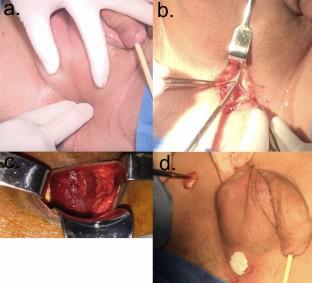International Urology and Nephrology ( IF 2 ) Pub Date : 2024-02-05 , DOI: 10.1007/s11255-024-03942-9 Rafael R. Zanotti , Fernando Lustosa , Andre C. Matos , Fernando Korkes , Claudio H. Toi , Luís G. M. de Toledo

|
Purpose
Patients with post prostatectomy incontinence (PPI) seem to have different needs. Therefore, device post-operative readjustability may be a beneficial feature in PPI management, even though it lacks study support. The purpose of this study is to describe our surgical technique for male sling (MS) implantation, assess outcomes, and the impact of readjustability.
Methods
We performed a retrospective analysis of 89 consecutive patients who underwent PPI correction with MS Argus-T™ (Promedon, Córdoba, Argentina) from 2009 to 2021. The median follow-up was 48 months (12–120). Data were collected in a dedicated database. Perioperative variables were assessed. A descriptive statistical analysis was performed. Clinical and urodynamic variables were correlated with the need for readjustments and success.
Results
In this cohort, objective success was achieved in 80.5% of the patients (65.9% cured and 14.6% improved). A total of 85.4% of the patients met the criteria for subjective success (74.4% cured and 11% improved). For the subgroup of patients who received previous treatment for urethral stricture (US), 79% achieved objective success (63.2% cured, 15.8% improved), and 84.2% achieved subjective success (78.9% cured, 5.3% improved). For the subgroup of patients who received previous radiotherapy (RT) before sling surgery, 68.7% achieved objective success (37.5% cured, 31.2% improved), and 75% achieved subjective success (37.5% cured, 37.5% improved). Procedures for device readjustment were necessary for 27.7% of patients in the total study population. RT and previous US treatment were predictive factors for the need of readjustment, with rates of 66.7% and 61.1% (OR: 8.46; CI: 2.46–29.00; p = 0.001/OR: 6.41; CI: 2.05–20.03; p = 0.001, respectively).
Conclusions
MS adjustability improved success rates, especially among irradiated patients and those with previous US. RT was an adverse predictor of total continence status even after readjustments.
中文翻译:

男性吊带的可调节性:这真的很重要吗?
目的
前列腺切除术后尿失禁(PPI)患者似乎有不同的需求。因此,装置术后可重新调整可能是 PPI 管理中的一个有益特征,尽管缺乏研究支持。本研究的目的是描述我们的男性吊带 (MS) 植入手术技术、评估结果以及可调整性的影响。
方法
我们对 2009 年至 2021 年间接受 MS Argus-T™(Promedon,科尔多瓦,阿根廷)PPI 矫正的 89 名连续患者进行了回顾性分析。中位随访时间为 48 个月(12-120)。数据收集在专用数据库中。评估围手术期变量。进行了描述性统计分析。临床和尿动力学变量与重新调整和成功的需要相关。
结果
在该队列中,80.5% 的患者取得了客观成功(65.9% 治愈,14.6% 改善)。共有 85.4% 的患者符合主观成功标准(74.4% 治愈,11% 改善)。对于先前接受尿道狭窄治疗的患者亚组(美国),79% 取得客观成功(63.2% 治愈,15.8% 改善),84.2% 取得主观成功(78.9% 治愈,5.3% 改善)。对于在吊带手术前接受过放疗 (RT) 的患者亚组,68.7% 取得客观成功(37.5% 治愈,31.2% 改善),75% 取得主观成功(37.5% 治愈,37.5% 改善)。总研究人群中 27.7% 的患者需要进行装置重新调整程序。放疗和既往超声治疗是需要重新调整的预测因素,发生率分别为 66.7% 和 61.1%(OR:8.46;CI:2.46–29.00;p = 0.001/OR:6.41;CI:2.05–20.03;p = 0.001 , 分别)。
结论
MS 的可调节性提高了成功率,尤其是接受过放射治疗的患者和既往接受过超声治疗的患者。即使在重新调整后,RT 也是完全失禁状态的不利预测因子。



























 京公网安备 11010802027423号
京公网安备 11010802027423号